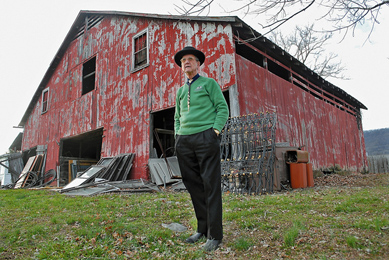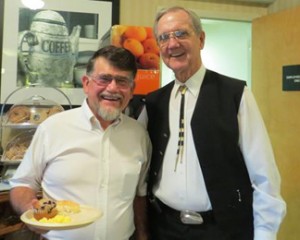Mountain Moonshine, Malfaesance and A Mother’s Misery

By Dr. Thomas Cloer, Jr. Special to The Courier
recently attended a high school class reunion near Stinking Creek in Campbell County in the high east Tennessee mountains. My family lived there when Gennett Lumber Company placed a
steam sawmill there with an enormous band saw, and my dad and relatives ran the mill. I graduated from high school there.
My wife, Elaine, originally from New York City, and I dated on Stinking Creek as we met while attending Cumberland College in nearby Kentucky. We often saw other couples sitting closely as we travelled to the sawmill. I can remember telling Elaine, “People can tell if you and I are married.”
“How can they do that?” she asked with a puzzled look.
“There’ll be snuff on both doors.” I joked.
“That is awful!” she said. “Just awful!”
There is a huge Hampton Inn in Caryville, Tenn., just below Stinking Creek off Interstate 75 North. I told Elaine we would stay there as we attended the reunion. As we entered the breakfast area, an old acquaintance of the Cloers appeared — Haskel “Hack” Ayers. He and I swapped tales and belly-laughed for an hour. We both had played high school football there, and both of our families had been heavily involved in sawmilling. He remembered my late dad, Carl, and my brother, Nat, who still has businesses and owns large tracts of land near Sand Gap and Stinking Creek. My wife was mostly silent as Hack and I monopolized the “tale bearin”.
•••••••
“Haskel Ayers seemed like an intelligent, interesting, and pleasant fellow. Tell me more about the moonshine you two mentioned more than once,” my wife said as we drove farther into the mountains toward my class reunion.
“Several of the men were former moonshiners who worked at the sawmill that my dad and relatives operated up here on Stinking Creek,” I explained.
“This county has always been very poor. More than half of the people here today live below the poverty level,” I said as I pointed to an Appalachian shack as we drove. “People had to make a living; some made whiskey and sold it to buy groceries and clothes.”
“When we get back to the Hampton Inn in Caryville, remind me to show you something,” I told my wife. “I won’t tell you now. See if you can guess what it is from what I relate to you about Hack and his family. As my dad would say, Hack has been dragged through hell backward by his heels. His life would make a great motion picture,” I said as we drove up the steep mountain toward our class reunion meeting place.
Stinking Creek and Sand Gap Moonshiners
Hack Ayers was from a family line of moonshiners. Hack’s father, from Stinking Creek, was John Ayers. He was known as “High Johnny” Ayers, in part because he was so tall. Hack’s grandfather, Bill Ayers, known as “High Billy,” and High Billy’s father had also lived as moonshiners in Sand Gap. When Elaine and I were dating at Cumberland College, I would often beg Elaine to spend the weekend with her college girlfriend who lived very close to Sand Gap. I would then also come home, and my future wife accompanied me as I hunted squirrels and ruffed grouse near Sand Gap.
John Ayers was more than just a moonshiner. John Ayers, like his son, Hack, was a gifted conversationalist. John was smart in business, and in addition to making moonshine, was a shrewd farmer, coal miner, and sawmiller. Hack joked that they lived so far back in the mountains, High Johnny wanted everyone to know he had been to LaFollette, Tenn., the little town where Elaine and I married.
John Ayers married Lassie Clepper in 1929. They had a daughter, Jerlene, and a son, Haskel. John and Lassie moved to LaFollette in 1938. LaFollette was the small town where Elaine and I married in 1965. It is also the little town where the snake-handling church is located that has been publicized so much recently. One of the preachers handling the serpents for the National Geographic special on television was killed doing so in the last year. After moving to LaFollette, Hack’s younger brother, R.L. Ayers, was born.
John Ayers borrowed money from Lassie’s mother, Easter Clepper, to buy that house in LaFollette. Entrepreneur that he was, John also sold beer on the first floor as he, Lassie, and the kids lived on the top floor. John built a special entrance for his mother-in-law to avoid the bottom floor, since his wife’s mother was devoutly religious.
John also owned and operated Colonial Cottage Motel and Restaurant on the edge of LaFollette. This was adjacent to a 35-acre farm that he owned. At this time, John also owned three different sawmills. The Ayers family owned the Colonial Cottage when my brother, Nat, married and moved there with his bride to one of the cottages in 1962.
Some of the patrons of John’s Colonial Restaurant in the 1940s were workers from the top-secret Manhattan Project in nearby Oak Ridge, Tenn., who were working with uranium to construct the ultimate weapon — an atomic bomb. The Manhattan Project eventually resulted in dominance by the United States in regard to nuclear weapons.
Moonshine and Malfeasance
It was glorious autumn in the Cumberland Mountains. No place on Earth is more picturesque than the towering Cumberlands when autumn’s colors are projected against the many and mighty rock outcroppings occurring seemingly everywhere.
School was out in Campbell County on Oct. 29, 1943, for in-service training for teachers. John asked his son, Hack, age 7, to ride with him very early in the morning to Middlesboro, Ken., adjacent to the historic Cumberland Gap. Hack arose at 6 a.m., and he and his father left LaFollette before daylight. They arrived in Middlesboro, where the Ball brothers were the big distributors of moonshine whiskey. High Johnny and Hack left “Ball’s Court” with 25 cases of moonshine whiskey and returned to their farm in LaFollette, where they stashed the whiskey near the barn in a chicken coop. John and Hack then went to John’s place of business.
Hack has related how his daddy was clever in concealing moonshine. High Johnny often hid the whiskey right out in the open, where no one would expect. For example, he often used large Appalachian wooden flower boxes with false bottoms. His sawmills provided plenty of lumber. The children were accustomed to getting out of bed when sirens were heard, and waiting while lawmen searched inside the house for concealed moonshine.
High Johnny Ayers, just into his forties, had no way of knowing that he had just made his last transaction, had viewed the dazzling Cumberland Gap in glorious autumn for the final time, or that he would, that beautiful autumn day in the Cumberland Mountains, leave his loving Lassie and beloved family forever.
At approximately 5:30 p.m. on that fateful October evening in 1943, Jerlene, Hack’s sister, called and said that five Tennessee Highway Patrol officers had come to the farm with a search warrant, and were out at the barn drinking and were high on the whiskey. John and his brother, Roscoe Ayers, headed to the farm with Hack in the back of the truck. High Johnny went by a friend’s house to retrieve a 12-gauge double-barrel shotgun. That was the biggest game-ending mistake High Johnny ever made. Roscoe had a .45-caliber pistol. When they arrived back home, Hack said his dad told him to go to his mother in the house. Hack ran to the kitchen, where his Mom was cooking for the uranium workers from Oak Ridge.
Jerlene, called Jerrie by friends, claimed that the Tennessee Highway Patrol had consumed enough of the whiskey to be drunk by the time John and Roscoe arrived. The evidence does suggest the lawmen that day were quite “loose.” The patrolmen allegedly opened fire and riddled the place with bullets as John and Roscoe arrived at the barn. There were 32 bullet holes in an old car John and Roscoe tried to hide behind. As John exposed his torso in the midst of the volley, a bullet caught him in just the wrong spot, just above a zipped pocket on his fine Sears and Roebuck brown leather jacket. Amazingly, Roscoe survived and was immediately arrested. When Lassie and Hack heard the hail of gunfire, they had run toward the barn. Hack raised his arms and stood still when “Halt!” was heard, but Lassie ran in terror and dread to her husband, to the crumpled, still body on the ground.
Hack was standing by the barn gate that day when the Minton Sharp Funeral Home took his father. Hack said he could see his dad as darkness encroached because a light was on inside the old hearse. The image still haunts Hack after all these years. There was no sheet or anything over his dad.
The fact that John and Roscoe Ayers had weapons would help the highway patrolmen, although malfeasance was a strong possibility. As hundreds gave their condolences, talk continued about the unfairness of it all. The troopers claimed that John Ayers had fired the 12-gauge at them, but no empty shotgun shells were ever found, and no one heard a shotgun blast. At a later hearing about the matter, warrants were issued against the five highway patrolmen, charging them with first-degree murder in the death of John Ayers. However, a grand jury refused to indict them. One of the five patrolmen was the chief, and another, a sergeant.
A Mother’s Misery
Hack said his mother was left alone to care for them, and she was overwhelmed. She, in bewilderment and desperation, had worried and wondered if they could survive and stay together. She let someone else rent and oversee the motel and restaurant for a year. She felt as if she and the children might be able to run the farm for food and meat to sell. Hack recalled that after much worry and misery, Lassie called her family together: Jerrie, 11, Hack, 7, and R.L, 3. She asked these small children if they could help before and after school if she tried to operate the Colonial Cottage. They promised to do whatever was necessary to live as a family and to stay together. Hack became a cook in their motel kitchen. Jerrie and R.L. also worked tirelessly and helped with the cottages and restaurant as if they were adults; the business flourished.
Hack later became a renowned auctioneer, for a while serving as president of the National Auctioneers Association; he is in their Hall of Fame. I remember vividly when Hack served as Campbell County Clerk of Court and ran several successful political campaigns for the Tennessee House of Representatives while we lived in Campbell County during the 1960s. Hack has been very successful in real estate and owns much property. He is a deeply religious fellow with a grand sense of humor and with malice toward none. He always said that his mother taught his siblings and him to honor God, work hard and get along with others. Lassie’s devout mother would have been proud of the family. Her influence would be realized for generations. Hack said of he and his siblings, “All three are Christians, non-smokers and teetotalers.”
Conclusion
“I saw the moonshine still that was there at the Hampton Inn. Was that what you were going to show me?” my wife asked as we descended from the mountains, returning from the class reunion to the Hampton Inn in Caryville.
“Nope, you will be moved emotionally when you see it,” I replied.
Lassie, Hack’s mother, died in the early 1970s after my family had moved to Pickens. Lassie had hung that Sears and Roebuck brown leather jacket that her husband was wearing when he was killed in the attic. In 1990, Hack found it, and it now hangs in the lobby of the Hampton Inn, in Caryville, Tenn., just one of many such businesses that Hack now owns. He also owns the Comfort Inn nearby. To this day, Hack still shows up to help in the kitchens at breakfast. When one sees the old brown leather jacket, one’s eyes are immediately drawn to that small bullet hole, squarely over his daddy’s heart, the bullet that would bring not only heart failure instantly to High Johnny, but also result in much heartfelt misery to this honest, humble, and hardworking Appalachian family from the Cumberland Mountains.
About the Author: Dr. Thomas Cloer Jr. is a professor emeritus at Furman University. He was an honor graduate of Jacksboro High School in Campbell County, Tenn., where he was chosen Most Valuable Football Player and Most Scholarly Football Player. He and his wife, Elaine, live in Pickens.




























